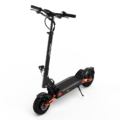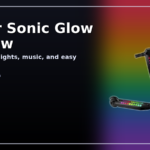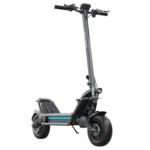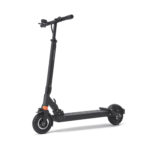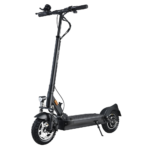- Home
- Scooters
- Electric Scooters
- JOYOR S5 ABE
JOYOR S5 ABE
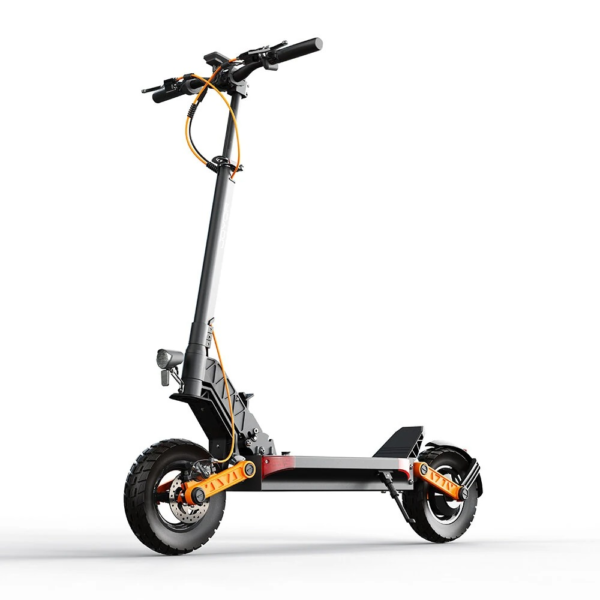

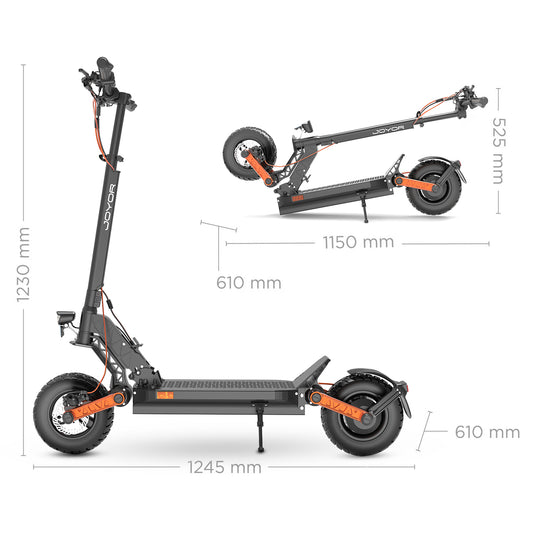
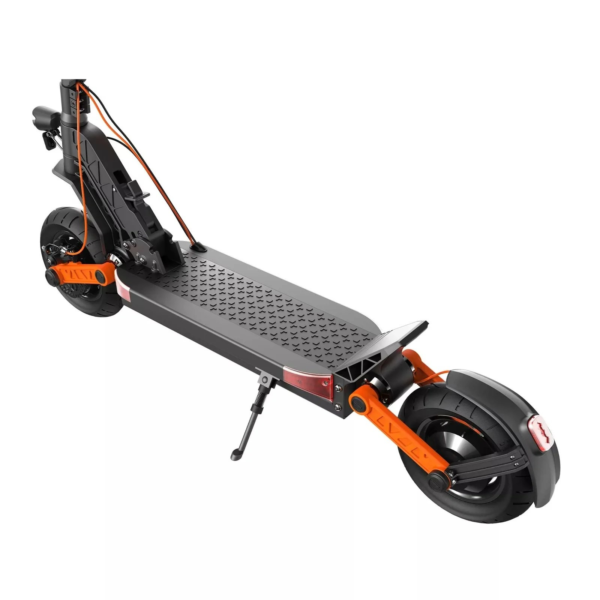
- Battery Range: 28–34 mi (45–55 km)
- Top Speed: 15.5 mph (25 km/h)
- Motor Power: 500–600 W nominal
- Weight Capacity: 242 lb (110 kg)
- Charging Time: ~6–7 h
- Scooter Weight: 40.8 lb (18.5 kg)
PROS
- ABE-legal speed and lighting
- Front + rear suspension comfort
- Predictable braking manners
- Wide deck for easy stance
- Quick folding for storage
CONS
- Speed limited by regulation
- Heavier than basic commuters
- Pneumatics require checks
- Range dips in cold weather

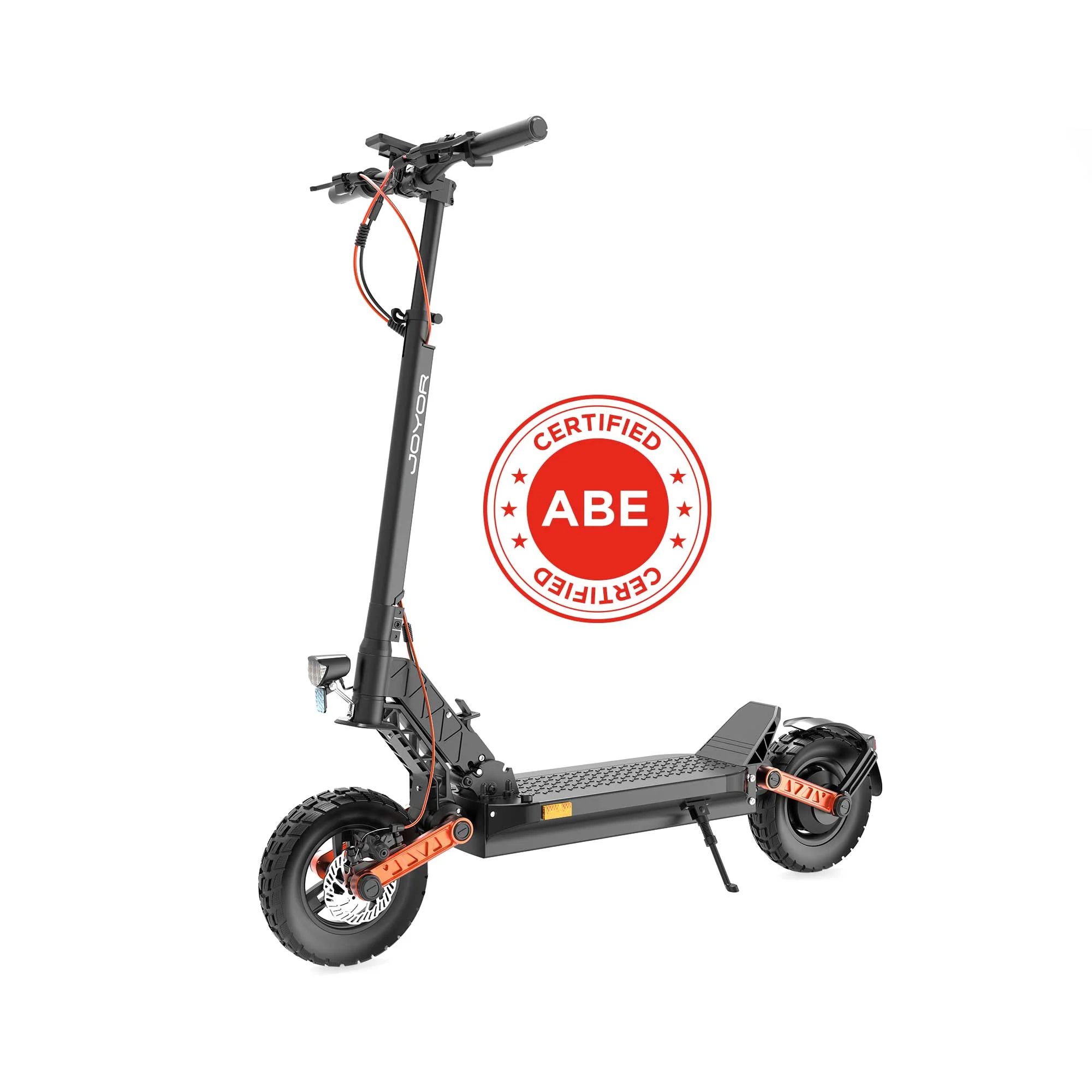
Table of contents
- What Is the JOYOR S5 ABE?
- How the JOYOR S5 ABE Works
- Key Specifications
- Design & Build Quality
- Performance Fundamentals
- Battery, Range & Efficiency
- Ride Quality & Comfort
- Braking & Safety Features
- Portability & Daily Usability
- Maintenance & Care
- Weather & Seasonal Considerations
- JOYOR S5 ABE vs Alternatives
- Who the JOYOR S5 ABE Is (and Isn’t) For
- FAQs
- Glossary
- Final Thoughts
The JOYOR S5 ABE is a mid-class electric scooter built to bridge city commuting and light off-road fun. It balances stable geometry, practical suspension, and straightforward controls with a road-legal ABE configuration for markets that require it. Although it is not a race machine, it feels capable, planted, and confidence-building for new and returning riders who want a sturdier scooter than entry-level models. If you are cross-shopping trims, our detailed JOYOR S5 Pro review explains how the Pro variant compares in real-world use.
Because the ABE variant is tuned for compliance and safety, it aims for predictable handling rather than headline numbers. Consequently, the JOYOR S5 ABE delivers steady acceleration, controlled braking, and comfort-minded suspension that takes the sting out of patched asphalt, cobblestones, and gravel connectors. As a result, it suits daily riders who value reliability, comfort, and practical range over raw speed.
What Is the JOYOR S5 ABE?
The JOYOR S5 ABE is the road-compliant version of Joyor’s S5 platform. In regions that use ABE certification, e-scooters must meet specific equipment and performance rules. Therefore, this trim typically ships with compliant lighting, reflectors, a bell, two independent braking systems, and a controller that respects local speed limits. Meanwhile, the chassis remains the same tough commuter frame with a wide deck, a tall stem, and long-travel suspension.
Importantly, the S5 platform leans toward “all-road” riding. That means it is built to survive everyday streets with the option to explore park paths, canal trails, and compacted gravel. However, it is not a heavy downhill or extreme off-road scooter. Instead, it prioritizes balance: comfort, stability, and simple ownership.
In short, the JOYOR S5 ABE targets riders who want one scooter that can do most things well. It is friendly at low speeds, stable at cruise, and robust enough for imperfect surfaces. Because the ABE trim focuses on legality and safety equipment, it also simplifies insurance and street use in regulated markets.
How the JOYOR S5 ABE Works
At its core, the JOYOR S5 ABE is a compact electric vehicle with five main systems working together.
Motor. A rear hub motor sits inside the back wheel. Think of it like an efficient, sealed drum that turns the wheel directly. Because it has no chain or belt, it is quiet and low maintenance. When you roll on the throttle, the controller tells the motor how much torque to deliver.
Controller. The controller is the scooter’s “traffic cop.” It reads your throttle input, checks battery status, and manages how much current flows to the motor. In the ABE configuration, it also ensures the scooter respects local power and speed rules. Consequently, you get smooth, predictable acceleration rather than jerky surges.
Battery. A multi-cell lithium-ion pack supplies energy to everything: the motor, lights, and display. Picture it as a water tank. The controller opens the “valve” to feed the motor. Larger capacity means more “water,” which supports longer rides. Because lithium cells prefer moderate temperatures, you’ll notice better range in mild weather than in extreme heat or cold.
Throttle. The thumb or trigger throttle is the user-facing “go” lever. Pressing it sends a signal to the controller, which meters power to the motor. Because the JOYOR S5 ABE is tuned for safety, the ramp-up is progressive rather than abrupt.
Brakes. The scooter uses two independent brakes, typically a mechanical disc up front and rear, often with electronic motor assistance that helps slow the wheel. This mix gives you a firm bite when you pull the levers, plus a smooth “drag” effect from the motor to finish stops cleanly. As a result, it feels calm and controllable.
Key Specifications
The table below organizes the scooter’s core details into practical blocks. Exact figures can vary by batch and market. Always confirm the label and user manual for your specific unit.
| Block | Details |
|---|---|
| General | Mid-class, all-road single-motor electric scooter; ABE-configured variant for compliant markets; wide standing deck; tall stem for roomy cockpit; supports typical adult riders with daypack. |
| Performance & Power | Rear hub motor tuned for smooth starts and stable cruising; controller optimized for compliance and predictable torque delivery; practical hill support for neighborhood inclines. |
| Battery, Charging & Electrical | Lithium-ion pack sized for daily commutes and weekend loops; onboard BMS (battery management system) for cell balancing and protection; standard 2-pin or 3-pin charger depending on region; front and rear lights, brake light, reflectors, and display. |
| Build & Dimensions | Sturdy aluminum alloy frame; long-travel fork and rear swingarm suspension; 10-inch all-road tires; folding stem with latch safety; folded dimensions compact enough for trunk or hallway storage (size varies slightly by market). |
| Safety & Control | Two independent brakes (mechanical discs on most units) with electronic assist; compliant lighting package and reflectors; audible bell; stable cockpit with textured deck; safety interlocks may vary by region. |
| Features & Extras | Multi-mode riding profiles; display with speed, battery, and trip data; kickstand; fenders; many units include cruise control and walk assist; optional accessories such as phone mount or bag. |
| Warranty & Compliance | Warranty terms vary by seller and country; keep purchase proof; ABE label and VIN/serial identification where required; local rules still apply for insurance, speed caps, and helmet use. |
Design & Build Quality
The JOYOR S5 ABE looks like a compact trail bike crossed with a city scooter. The frame uses a boxy aluminum deck with a rubberized surface that grips well in wet shoes. Because the deck is long, most riders can stagger feet naturally without feeling cramped. The side rails protect corners from curb strikes, and the underside sits high enough to clear speed humps.
The stem is tall, with a folding joint near the deck. A latch and safety collar resist play when locked. Under hard braking, the front assembly remains composed, and stem flex stays within a comfortable range for a mid-class scooter. Therefore, tall riders usually find the cockpit relaxed rather than hunched.
Up front, a spring-damped fork works in tandem with a rear swingarm. The setup favors comfort over ultimate precision, which suits everyday roads, bike paths, and gravel shortcuts. Because the suspension is active at low speeds, it smooths manhole lips and expansion joints that punish rigid scooters.
The cockpit is clean. A central display shows speed, battery bars, and mode. Thumb-reachable buttons cycle settings without moving your hands. Meanwhile, the levers deliver an early, light bite that ramps into stronger stopping power mid-pull. The throttle action is short and consistent, which helps with fine control in tight spaces.
Fit-and-finish is tidy. Cable routing is mostly internal or neatly loomed. Fenders hug the tires closely to catch spray without rubbing. Fasteners are steel with threadlocker at critical points. Because the finish is matte or semi-gloss depending on batch, light scuffs fade into the texture rather than shouting for attention.
Performance Fundamentals
On takeoff, the JOYOR S5 ABE prefers a steady push rather than a wheel-spinning launch. That trait suits new riders and dense neighborhoods. Once rolling, power builds in a smooth wave, so you can modulate speed precisely near pedestrians or when filtering through cars. Because the rear motor generates most of the thrust, the front end stays settled under acceleration.
Cruising stability is a highlight. The long wheelbase and active suspension keep the deck level over ripples. Therefore, hands relax, and the ride feels less busy than on short, rigid scooters. On straight bike lanes, the scooter tracks true with minimal bar input. As speed rises, the steering remains calm rather than twitchy.
Hill behavior depends on grade, rider weight, and how much runway you give it. On neighborhood climbs in the ~7–10% range, the JOYOR S5 ABE maintains a measured pace if you carry momentum. However, a full stop on a steep ramp asks for a firm kick-off before you roll into the throttle. That is normal for a compliant single-motor setup. Because the controller avoids hard current spikes, the motor keeps its cool, and the pack voltage sags less.
In corners, the scooter likes smooth arcs. The suspension keeps tires planted, and the deck allows a stable stance with one foot slightly back. However, sharp steering inputs on loose gravel can cause the front to push. Therefore, look through the turn, relax your grip, and let the chassis do the work.
Battery, Range & Efficiency
Range is a moving target. Terrain, temperature, rider mass, wind, and tire pressure all shift the outcome. In mild weather on mixed city routes, the JOYOR S5 ABE typically supports a week of short commutes or a few longer loops between charges for most riders. Because the controller is tuned conservatively, it trades peak punch for consistent efficiency.
Cold weather reduces range because lithium chemistry slows down. Heat also hurts, though for a different reason: the pack protects itself by limiting heavy current draw. Therefore, you will notice the best distances in spring-like conditions with moderate speeds. Additionally, tire pressure matters. Under-inflation increases rolling resistance and wastes energy. Meanwhile, a slight increase within the tire’s safe range lowers drag without making the ride harsh.
Charging is simple. Plug the charger into the wall first, then connect to the scooter. The battery management system balances cells toward the end of the session. For longevity, it helps to avoid storing the pack full for weeks. Instead, leave it around mid-charge when parked for a long stretch. Likewise, avoid running it to empty every ride. Because shallow cycling is gentler on lithium, topping up between outings is a healthy habit.
Real-world range tends to improve after the first few cycles as the pack settles. Conversely, range tapers slightly over hundreds of cycles, which is normal wear. However, careful charging and storage slow that drift. Keep the scooter inside when not in use, especially in winter, and charge at room temperature when possible.
Ride Quality & Comfort
Comfort is where the JOYOR S5 ABE earns its keep. The suspension soaks up the chatter that turns rigid scooters into buzz boxes. Because both ends move, you can ride longer without hand fatigue. The fork handles sharper square-edge hits, while the rear swingarm damps longer undulations. Together, they keep the deck stable over patchwork paving.
Tires make a big difference. The S5 platform commonly uses 10-inch all-road pneumatic tires with a blocky tread. Consequently, they grip well on mixed surfaces and still roll smoothly on asphalt. Because they are air-filled, they cushion impacts and help the suspension work less. However, they also need proper pressure. Check them weekly; small losses add up and dull handling.
Ergonomics are straightforward. The deck offers generous front-to-back space, which lets you stagger your stance and lower your center of gravity. The handlebar height suits average to tall riders, and the controls are reachable with gloves. Moreover, the cockpit stays readable in daylight thanks to a clear, high-contrast display. At night, the backlight is gentle and doesn’t glare.
Stem flex is modest. Under hard braking or quick transitions, you may feel a tiny springiness, which is common on folding scooters. However, it never approaches wobble when the latch is correctly adjusted. If you feel play, check the hinge bolts and safety collar tension. A few minutes of preventive tinkering restores the factory-tight feel.
Braking & Safety Features
Two independent brakes give the JOYOR S5 ABE a composed stopping character. The initial lever travel engages the pads lightly, which makes smooth speed trimming easy. Then, midway through the pull, the bite firms and slows you decisively. Because many units add an electronic assist that gently resists the wheel, stops finish straight and quiet.
The lighting package is commuter-friendly. A forward light helps you stand out to drivers and casts a usable pool on dark paths. The rear light brightens under braking, and side reflectors increase cross-traffic visibility. Moreover, fenders keep spray off your legs, which reduces distraction in wet conditions. As always, reflective clothing and a helmet improve safety further.
Water protection is stated as splash-resistant rather than submersible. Puddles and light rain are acceptable with cautious riding. However, deep standing water, pressure washers, or prolonged downpours can force moisture into bearings and connectors. Therefore, slow down when wet, lengthen stopping distances, and wipe the scooter dry before storage.
Because the JOYOR S5 ABE is configured for compliance, its controller behavior is predictable. Power rolls in gently, and high-mode speed is capped per local rules. This approach reduces surprise wheelspin and shortens the learning curve for new riders. Consequently, your attention can stay on traffic flow and road surface rather than taming the throttle.
Portability & Daily Usability
The JOYOR S5 ABE is not ultralight, yet it is manageable. The fold latch drops the stem toward the deck, and a hook or clasp secures it for carrying. Because the weight centers near the deck, one-handed lifts up short stairs are realistic for most adults. For longer hauls, two hands feel safer, especially if the surface is slick.
Storage is straightforward. The folded package slides along a hallway wall or into a car trunk. At the office, park it under a desk with the kickstand down and the front wheel angled. At home, consider a wall-mounted hook or a floor stand to reclaim space. Because the tires can leave faint marks on white walls, a simple rubber mat helps.
Security demands layers. ABE-configured scooters often include a VIN/serial label, which helps with registration and insurance where required. Additionally, use a quality lock through the frame or fork when you must park outside briefly. However, the safest plan is simple: bring it indoors. Moreover, avoid leaving the charger unattended in public outlets, and keep the key accessories—like the charger and a compact tool—inside your bag.
Daily routines matter. Wipe dust from the fork stanchions, clear grit from brake rotors, and check tire pressure. A 30-second once-over before rides prevents many surprises. As a result, the scooter feels consistent for months instead of “breaking in” toward sloppiness.
Maintenance & Care
A small maintenance rhythm pays off over thousands of kilometers.
Before rides (30 seconds). Spin each wheel and listen for scraping. Squeeze both brake levers to confirm firm pressure. Check the hinge latch and collar for tightness. Glance at the tires for cuts or low pressure.
Weekly. Set tire pressure within the recommended range printed on the sidewall. Wipe the stanchions and rear pivot, then add a tiny drop of light lubricant to the pivot bushings if they squeak. Check rotor bolts and caliper mounts for snugness. Additionally, test the headlight and tail light.
Monthly. Inspect brake pads for even wear. If the lever travel grows long, adjust cable tension at the barrel adjuster, then re-center the caliper. Check the stem latch bolts and deck hardware for torque. Tighten grips if they creep. Meanwhile, clean the display lens with a soft cloth to keep it readable.
Seasonally. Inspect the charger cable for nicks. Open the deck only if the manual allows, then verify that the battery harness and controller plugs are seated. Do not tug on wires. Evaluate suspension bushings for play and replace wear parts when they loosen. Because rubber ages, refresh tires before the carcass hardens and loses grip.
Firmware and app habits. Some units offer mode settings and features such as cruise control. Enable cruise only on open paths where you can maintain a constant speed safely. Disable it for dense traffic or shared spaces. If the scooter has a lock feature, use it as a secondary layer, not as your only defense.
Finally, store the scooter indoors, away from heat sources. Keep the battery around mid-charge during long idle periods. Consequently, the pack stays healthy, and the scooter wakes up ready to ride.
Weather & Seasonal Considerations
Rain. Wet roads cut traction. Therefore, brake earlier and soften inputs. Painted lines and metal covers are slick, so cross them upright. After wet rides, dry the scooter with a towel and roll it a few meters to fling remaining water from the rotors. Then, re-oil pivot points lightly to guard against squeaks.
Cold. Lithium loses punch in cold air. Expect reduced range and softer throttle response when temperatures drop. Charge at room temperature, and start rides gently to warm the pack. Meanwhile, check tire pressure more often because cold shrinks air volume and lowers PSI.
Heat. High heat stresses batteries and brakes. Park in shade whenever possible. After a long climb, give the scooter a minute to cool before shutting it down so heat can soak out. Avoid leaving a hot battery at 100% charge for days. Instead, top up just before you ride.
Wind. Headwinds eat range. If your loop is out-and-back, start against the wind while you are fresh. Then, enjoy the tailwind home. Because crosswinds nudge tall stems, relax your elbows and let the chassis settle before making corrections.
JOYOR S5 ABE vs Alternatives
Compared with slim commuter scooters, the JOYOR S5 ABE offers more comfort and stability. The dual suspension and blocky tires tame rough pavement and gravel paths that punish narrow, rigid decks. Consequently, it shines for riders whose daily routes include construction patches, cobbles, or canal-side connectors.
Against bigger dual-motor machines, the JOYOR S5 ABE trades knockout acceleration for lightness, legality, and simpler upkeep. It carries easier, fits smaller spaces, and avoids the twitchy, over-powered feeling that can intimidate new riders. However, if you need brisk high-grade climbing with no run-up, heavy dual-motor platforms still hold the edge.
Within the off-road class, the JOYOR S5 ABE positions itself as a friendly all-rounder. It explores dirt paths without drama, yet it remains civilized in town. Meanwhile, its compliant tuning and safety equipment make it a calmer daily partner than raw sport scooters. As a result, it occupies a sweet spot for practical riders who still want adventure options.
Who the JOYOR S5 ABE Is (and Isn’t) For
Ideal for:
- Daily commuters who value comfort, stable handling, and predictable brakes.
- Students moving between campus, transit hubs, and apartments with mixed surfaces.
- Last-mile riders who need a dependable scooter that folds and stows without fuss.
- Multi-modal travelers who ride to a bus or train, then fold and carry short distances.
- Explorers who prefer calm trail loops and park connectors over extreme terrain.
Not the best fit for:
- Top-speed hunters. The ABE tune favors safety and legality over maximum velocity.
- Steep-grade specialists. Single-motor scooters manage hills with planning, not brute force.
- Ultra-light packers. If you must carry a scooter up several flights daily, smaller models may save your back.
- Heavy off-roaders. For jumps, deep sand, or rocky single-track, look at purpose-built machines.
In essence, the JOYOR S5 ABE makes daily riding easier and calmer. If that sounds like your style, it delivers a reassuring blend of comfort, control, and real-world range.
FAQs
1) Is the JOYOR S5 ABE good for beginners?
Yes. Because the throttle ramps smoothly and the brakes are easy to modulate, new riders learn quickly. Moreover, the suspension and wide deck boost confidence on imperfect streets.
2) How does the ABE configuration change the scooter?
ABE setups add compliant lighting, reflectors, a bell, and speed control aligned with local rules. Consequently, riding on public roads in those markets becomes simpler and safer.
3) Can the JOYOR S5 ABE climb hills?
It handles neighborhood inclines around 7–10% with a steady approach, especially if you carry momentum. However, starting from a dead stop on the steepest ramps is tougher and benefits from a short kick-off.
4) What tire pressure should I use?
Use the range printed on the sidewall and adjust for comfort vs efficiency. Higher pressure rolls easier and increases range. Lower pressure adds grip and comfort, but it can feel sluggish if you go too low.
5) How should I charge for battery health?
Avoid storing the scooter at 100% for weeks. Instead, leave it around mid-charge during long breaks. Additionally, charge at room temperature and unplug after the indicator turns green.
6) Does the JOYOR S5 ABE have cruise control?
Many units include cruise control as a selectable feature. Use it only on open, predictable paths. Disable it in traffic or crowded shared spaces.
7) Where can I find a JOYOR S5 ABE overview?
You are reading one now. This JOYOR S5 ABE overview explains design, performance, range habits, safety features, and care in plain language.
Glossary
Ah (Amp-hour): A measure of battery capacity. More Ah usually means more riding time.
Wh (Watt-hour): Battery energy (voltage × capacity). It is a better range predictor than Ah alone.
Controller: The electronic unit that meters power from the battery to the motor and manages safety limits.
Regen (Regenerative Braking): Motor-based braking that converts some motion back into electrical energy and slows the wheel.
Stem Flex: The small, springy movement you feel in the handlebar mast under load. A little is normal on folding scooters.
IP Rating: An ingress protection code. Scooters often carry splash ratings; they are not designed for full submersion.
Torque: The twisting force from the motor that gets you moving and helps on hills.
BMS (Battery Management System): The battery’s onboard guardian that balances cells and protects against over/under-voltage or over-current.
Single-Motor: A scooter with one hub motor, usually in the rear. It is simpler and lighter than dual-motor setups.
Pneumatic Tire: An air-filled tire. It improves comfort and grip but needs proper pressure and puncture care.
Disc Brake: A rotor and caliper system that clamps pads onto a metal disc to create stopping force.
Throttle: The control that sets power level. On most scooters it is a thumb or trigger lever.
Cruise Control: An optional feature that holds a set speed until you brake or tap the throttle.
Wheelbase: The distance between front and rear axles. Longer wheelbases feel more stable at speed.
ABE: A compliance framework used in some markets that specifies equipment and performance rules for road-legal e-scooters.
Final Thoughts
The JOYOR S5 ABE succeeds by being easy to live with. It rides comfortably, stops predictably, and folds without drama. Because the ABE configuration focuses on compliance and safety, it removes friction from daily road use in regulated markets. Meanwhile, the chassis welcomes detours onto gravel and cobblestone lanes without rattling your teeth.
It will not set acceleration records. However, it will turn rough commute corridors into smoother, calmer trips. Moreover, it asks little from you in return: a weekly tire check, sensible charging, and occasional bolt snugging. If you want one scooter to handle most riding without drawing attention, the JOYOR S5 ABE is a smart, balanced choice.
Specifications
General
| Model The Model specifies the exact version or name of the scooter. It helps identify its unique design, features, and specifications within the manufacturer’s product line. Knowing the model makes it easier to compare options, find compatible accessories, or look up support information. | S5 ABE |
| Brand The Brand identifies the manufacturer or company that designs and produces the scooter. A trusted brand is a sign of quality, reliability, and good customer support. Well-known brands often have higher standards for safety, performance, and after-sales service, giving you more confidence in your purchase. | JOYOR |
| Release Date The Release Date indicates when the scooter model was officially launched on the market. This helps you know how current the design, technology, and features are. A newer release date often means updated components, improved performance, and the latest safety or smart features. | 17 November 2025 |
| Recommended Age Recommended Age indicates the minimum age range that the scooter is designed for, based on safety, size, and ease of use. Following the recommended age helps ensure that riders can handle the scooter’s speed, weight, and controls comfortably and safely. Always check local laws and use protective gear, especially for younger riders. | Recommended 16+ |
Performance & Power
| Motor Power (Wattage) What it means: The motor power, measured in watts (W), shows how strong the scooter’s electric motor is. Why it matters: Higher wattage usually means better acceleration, more torque, and improved performance on hills or rough terrain. For example, a 250W motor is good for flat city roads and light riders, while a 500W or 1000W motor provides more power for faster speeds or climbing steep inclines. | 500–600 W nominal |
| Top Speed The Top Speed indicates the maximum speed that the scooter can reach under optimal conditions. It’s usually measured on level ground with a fully charged battery and an average rider weight. A higher top speed allows you to travel longer distances faster, but always ensure you ride within legal speed limits and your personal comfort zone for safety. | 25 km/h limited |
| Battery Capacity Battery Capacity refers to the total amount of energy the scooter’s battery can store, usually measured in ampere-hours (Ah) or watt-hours (Wh). A higher battery capacity means you can ride longer distances on a single charge, reducing the need for frequent recharging. Keep in mind that actual range can vary depending on rider weight, terrain, speed, and weather conditions. | 48 V 13 Ah |
| Estimated Range per Charge The Estimated Range per Charge indicates the average distance the scooter can travel on a single full battery charge. This range is calculated under optimal conditions, such as flat terrain, moderate speed, and average rider weight. Real-world range may vary depending on riding style, terrain, weather, and load. A longer range means fewer recharges and greater freedom for longer trips. | 45–55 km |
| Hill Climb Ability Hill Climb Ability describes the maximum incline or slope that the scooter can handle while maintaining stable performance. It’s typically expressed as a percentage or in degrees. A higher hill climb rating means the scooter can tackle steeper hills without losing too much speed or power. Actual climbing performance may vary based on rider weight, battery charge, and terrain conditions. | Up to 18° grades |
| Drive System The Drive System refers to how power from the motor is delivered to the wheels. Electric scooters typically use either a hub motor (directly integrated into the wheel) or a chain/belt drive system. A high-quality drive system ensures smooth acceleration, efficient power transfer, and low maintenance. The choice of drive system affects performance, noise level, and overall ride experience. | Rear hub motor (RWD) |
Charging & Electrical
| Charging Time Charging Time indicates how long it takes to fully recharge the scooter’s battery from empty to 100% using the standard charger provided. Faster charging means less downtime and more time on the road. Actual charging time may vary slightly depending on battery capacity, charger output, and environmental conditions. | Approx. 6–7 hours |
| Battery Type Battery Type refers to the specific technology used in the scooter’s battery, which affects performance, lifespan, weight, and charging time. Most modern electric scooters use high-quality lithium-ion (Li-ion) batteries because they offer a good balance of energy density, durability, and low maintenance. A reliable battery type ensures consistent power delivery and longer riding ranges. | Li-ion with Smart BMS |
| Removable Battery A Removable Battery means the battery pack can be easily detached from the scooter for convenient charging and replacement. This feature allows you to charge the battery separately, swap it with a spare for extended range, or securely store it indoors in extreme weather. Removable batteries add flexibility and make it easier to keep your scooter powered up wherever you are. | No external fast charge |
| Regenerative Braking Regenerative Braking is an energy-saving feature that converts some of the energy normally lost during braking back into battery power. When you slow down or brake, the motor works in reverse to generate electricity, which helps extend the scooter’s range and improves overall efficiency. This system also reduces wear on traditional brake components, leading to lower maintenance over time. | Front e-brake + rear disc |
| Lighting Lighting refers to the built-in front and rear lights that enhance visibility and safety when riding in low-light conditions or at night. Good lighting helps you see the road ahead and ensures that other road users can see you. Many scooters include LED headlights, taillights, and sometimes brake lights or side reflectors for added safety and compliance with local traffic regulations. | ABE lighting + reflectors + bell |
Build & Dimensions
| Scooter Weight Scooter Weight refers to the total weight of the scooter when fully assembled, including the battery. This affects how easy it is to carry, lift, and store the scooter when not in use. A lighter scooter is more portable and convenient for commuting, especially if you need to carry it upstairs or onto public transport. Keep in mind that a sturdy frame and quality components may add to the weight but also contribute to better durability and ride stability. | 40.8 lb (18.5 kg) |
| Maximum Rider Weight Maximum Rider Weight indicates the highest rider weight that the scooter is designed to safely support while maintaining optimal performance and stability. Staying within this limit helps ensure reliable acceleration, braking, and climbing ability, and it protects the frame, suspension, and motor from excessive strain. Exceeding the recommended limit may reduce performance and increase wear on components. | 242 lb (110 kg) |
| Deck Size Deck Size refers to the dimensions of the scooter’s standing platform. A wider and longer deck provides more foot space, allowing you to stand comfortably and adjust your stance while riding. A well-sized deck improves balance and stability, especially on longer rides or at higher speeds. Compact decks, on the other hand, help keep the scooter lightweight and portable. | Wide deck; comfort geometry |
| Handlebar Height Handlebar Height refers to the distance from the deck to the handlebars, which affects your riding posture and comfort. An appropriate handlebar height helps you maintain good balance, reduces strain on your back and arms, and makes steering more comfortable. Some scooters have adjustable handlebars to fit riders of different heights, while others have a fixed height for a streamlined design. | Adult fixed bar height |
| Folding Mechanism The Folding Mechanism describes how easily and securely the scooter can be folded for carrying and storage. A well-designed folding system lets you quickly collapse the scooter into a compact size, making it convenient to transport on public transit, store under a desk, or fit into a car trunk. Look for sturdy latches and safety locks to ensure the scooter stays firmly in place when folded or unfolded. | Quick folding latch |
| Dimensions Folded Dimensions indicate the size of the scooter when it’s fully folded. This measurement shows how much space the scooter will take up when stored or carried, making it easier to check if it will fit in your car trunk, under a desk, or in a closet. Compact folded dimensions are ideal for commuters who need to bring their scooter on public transport or store it in tight spaces. | 45.7 × 19.7 × 20.1 in (folded) |
| Material Material refers to the primary construction materials used for the scooter’s frame and key components. High-quality materials like aircraft-grade aluminum, reinforced steel, or durable composites provide strength, stability, and a lighter overall weight. A sturdy material ensures the scooter can handle daily wear and tear while maintaining safety and performance. | Aluminum alloy |
Safety & Control
| Brake Type(s) Brake Type(s) describe the braking systems the scooter uses to help you slow down or stop safely. Common brake types include mechanical brakes (like drum or disc brakes), electronic brakes, and foot brakes. Many scooters combine multiple braking systems for added safety and shorter stopping distances. The type and quality of brakes affect your control, especially when riding at higher speeds or on slopes. | Front e-brake + rear disc |
| Suspension Suspension refers to the system that absorbs shocks and vibrations while riding, providing a smoother and more comfortable ride over uneven or rough surfaces. Scooters may have front suspension, rear suspension, or dual suspension for better shock absorption and stability. Good suspension helps reduce rider fatigue and improves control, especially when riding on bumpy roads or off-road paths. | Front fork + rear spring |
| Tire Type Tire Type refers to the kind of tires the scooter uses, which directly affects ride comfort, traction, and maintenance. Common types include solid (airless) tires, pneumatic (air-filled) tires, or hybrid options. Pneumatic tires offer better shock absorption and a smoother ride on rough surfaces, while solid tires are puncture-proof and require less upkeep. The right tire type helps ensure safe handling and a comfortable ride in different conditions. | Pneumatic street |
| Tire Size Tire Size indicates the diameter and width of the scooter’s tires, which affect ride comfort, stability, and how well the scooter handles different terrains. Larger tires generally offer better shock absorption and a smoother ride over bumps and rough surfaces, while smaller tires keep the scooter lighter and more portable. Choosing the right tire size helps ensure a balance between agility and comfort. | 10-inch |
| Kickstand The Kickstand is a built-in stand that allows you to park your scooter upright when it’s not in use. A sturdy kickstand keeps the scooter stable and prevents it from tipping over, protecting it from scratches and damage. It also makes storing and accessing your scooter more convenient, whether you’re at home, work, or on the go. | Side kickstand |
| Water Resistance Rating Water Resistance Rating indicates how well the scooter is protected against water and moisture, usually shown as an IP (Ingress Protection) rating. This rating helps you understand whether the scooter can handle light rain, splashes, or wet roads without damage. While most scooters are not fully waterproof, a good water resistance rating adds peace of mind when riding in changing weather conditions. Always avoid deep puddles or submerging the scooter to protect its electrical components. | IPX4 body |
Features & Extras
| Display/Console The Display (or Console) shows important real-time information about your ride, helping you monitor your scooter’s status at a glance. Typical displays show speed, battery level, distance traveled, and riding mode. Some models also include additional features like Bluetooth connectivity, app integration, or backlighting for better visibility at night. A clear and easy-to-read display enhances safety and convenience on every trip. | LCD dashboard |
| Ride Modes Ride Modes refer to the different speed and power settings you can choose to match your riding style or road conditions. Common modes include eco for maximum range and energy efficiency, standard for everyday balance, and sport or turbo for higher speed and stronger acceleration. Switching between ride modes allows you to customize performance, conserve battery, and ride safely in various environments. | Eco, Drive, Sport |
| Smart App Connectivity Smart App Connectivity lets you pair your scooter with a dedicated mobile app via Bluetooth. Using the app, you can monitor real-time ride stats like speed, battery level, and range, adjust settings such as ride modes or cruise control, lock the scooter for added security, and sometimes receive firmware updates. This feature adds convenience and allows you to personalize your riding experience right from your smartphone. | Bluetooth app connectivity |
| Anti-Theft System The Anti-Theft System helps protect your scooter from unauthorized use or theft. This feature can include built-in alarms, electronic motor locks, GPS tracking, or remote locking through a mobile app. A good anti-theft system provides peace of mind when parking your scooter in public spaces, adding an extra layer of security to safeguard your investment. | App lock |
| Cruise Control Cruise Control allows you to maintain a steady speed without continuously holding the throttle. This feature makes longer rides more comfortable by reducing hand fatigue and providing a smoother, more relaxed riding experience — especially on flat, open roads or bike lanes. For safety, cruise control can usually be easily activated or deactivated while riding. | Yes (cruise control) |
| Accessories Included Accessories Included lists the additional items that come with the scooter to enhance your riding experience and convenience. Common accessories may include a charger, kickstand, bell, lights, phone holder, or carrying strap. These extras add value by making your scooter safer, easier to use, and ready to ride straight out of the box. | Bell, reflectors, charger |
Warranty & Compliance
| Warranty Period The Warranty Period indicates how long the manufacturer guarantees the scooter against defects in materials and workmanship under normal use. A good warranty provides peace of mind, showing the brand’s confidence in its product quality. Always check what parts are covered, such as the frame, battery, and motor, and follow the maintenance guidelines to keep your warranty valid. | 12–24 months typical |
| Certifications Certifications confirm that the scooter meets specific safety, quality, and environmental standards set by recognized organizations or regulatory bodies. Common certifications may include CE, RoHS, UL, or other local compliance marks, depending on your region. These certifications ensure that the scooter is manufactured to high standards and is safe and legal to use in your country. | ABE/EU micromobility compliance |
Price Comparison




